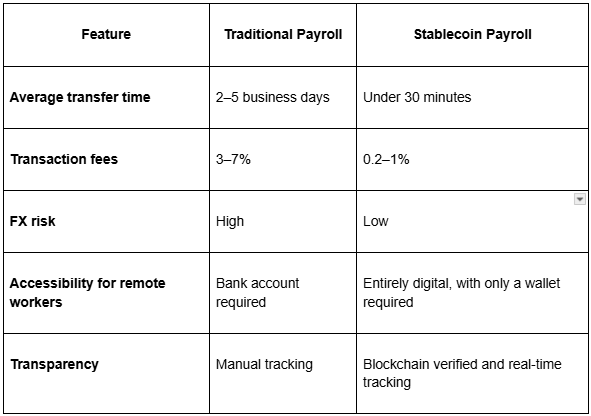Traditional bank transfers can be time-consuming, expensive, and cumbersome, particularly when dealing with international payroll. With stablecoin payments for business, on the other hand, there is near-instant settlement, fixed costs, and an efficient workflow for international teams. Which is why businesses in the Philippines and around the world are seeking ways to pay Filipino remote workers with stablecoins.
This blog discusses how one can pay Filipino remote workers with stablecoins, USDT and USDC payments for employees, how to convert stablecoins to PHP, crypto payment platforms for businesses, and much more.
How Businesses Can Pay Filipino Remote Workers with Stablecoins
Paying employees with crypto doesn't have to be complicated. The first step is picking reliable stablecoins like USDT or USDC, which are popular for freelancer stablecoin payments because their value stays steady and they work with many exchanges and wallets.
From there, companies typically set up a wallet or account on a reliable crypto payment platform for businesses, fund it with stablecoins, and send payroll directly to employees’ wallets. Employees can then convert their stablecoin salaries to cash through local exchanges, all while staying compliant with Philippine regulations.
With TransFi, businesses can automate the entire process from sending payroll, accepting stablecoins, and converting to PHP, securely through one platform.
Next, let’s look at the advantages of paying in stablecoins.
Benefits of Paying in Stablecoins
The benefits of paying Filipino remote workers with stablecoins are real. Companies reduce bank fees, speed up payroll, and make cross-border transactions easy. For workers, payments through crypto payroll in the Philippines mean quicker access to funds and the possibility of converting to PHP without intermediary latencies.
Using USDT and USDC payments for employees guarantees a steady value when exchanged for local currency, eliminating FX risks prevalent in cross-border payroll. This is especially beneficial for freelancers and remote workers to get uniform and predictable pay. By implementing stablecoin payroll solutions for small businesses, companies are able to tap into talent across the globe while keeping operations cost-effective.
Comparison: Traditional Payroll vs Stablecoin Payroll

Also read about: Top Risks of Using Stablecoins for Businesses (and How to Reduce Them)
Step-by-Step Guide to Paying Employees in Crypto
Here’s a straightforward step-by-step guide to paying employees in crypto:
- Calculate payroll amounts and choose stablecoins (USDT or USDC).
- Fund your wallet through a licensed crypto payment platform for businesses such as TransFi.
- Transfer funds directly to employees’ wallets.
- Employees can convert stablecoin salaries to cash or hold crypto if they wish.
- Keep records for accounting and tax purposes.
This approach is the safest method for freelancer stablecoin payments and crypto payroll options for international contractors, reducing errors and ensuring reliable salary delivery.
Once you have received your money in stablecoins, next comes the question of converting them into spendable cash. Moving forward let's discuss how to convert stablecoins to PHP.
How to Convert Stablecoins to PHP
Once employees receive stablecoins, they can use licensed local exchanges or wallet-to-bank conversion features.
TransFi facilitates this effortlessly by directly converting USDT or USDC to PHP, skipping usual delays, and keeping fees low. With TransFi, users can withdraw directly to domestic e-wallets such as GCash, Maya, or to any Philippine bank account, providing employees maximum convenience and flexibility.
Additionally, TransFi ensures that all conversions are fully secure, compliant, and traceable, minimizing delays and keeping fees low. This means your team can access their earnings instantly, without juggling multiple platforms or intermediaries, while your business stays fully aligned with Philippine regulations.
Integration and Compliance Tips
Bringing crypto into your payroll does not need to be complex. Most businesses begin by paying employees with crypto together with conventional means, providing employees with flexibility while easing the transition.
It is crucial to monitor all transactions, keep accounting in order, and ensure your team can convert stablecoins to PHP for daily use. Doing this not only makes payroll run smoothly but also ensures secure crypto payments for workers as well as compliance with Philippine regulations and international labor standards.
Using a reliable platform such as TransFi can make this even simpler because it facilitates secure transfers, maintains clear records, and remains fully compliant, so you can concentrate on expanding your business instead of needing to concern yourself with payroll logistics.
Choosing the Right Stablecoins and Platforms
For safest stablecoins for payroll payments, USDT and USDC are recommended due to liquidity, reliability, and widespread adoption. Paying freelancers using USDT or USDC ensures minimal volatility and easy conversion to PHP.
Equally important is picking the right crypto payment platforms for businesses. You want one that’s licensed, secure, and transparent. Platforms offering blockchain payroll systems and transparent conversion rates allow companies to avoid fees when paying remote workers with crypto while keeping transfers traceable and compliant.
Future Outlook for Stablecoin Payments for Businesses
The prospects of stablecoin payroll in the Philippines look bright. With increasing crypto adoption, more startups and SMEs will use stablecoins for cheaper, quicker, and more reliable payments. Platforms like TransFi are well-placed to fuel this growth by offering end-to-end solutions that cover everything from stablecoin transfers to local currency exchange, making stablecoin payroll solutions for small businesses and big companies effortless.
For companies that want to employ international talent and are looking forward to paying Filipino remote workers with stablecoins, talk to an expert at TransFi today and discover how you can utilize stablecoins for payroll, save money, as well as expand abroad with confidence.
FAQs
- How can businesses pay Filipino remote workers with stablecoins safely?
Businesses can utilize authorized wallets or platforms, choose stablecoins such as USDT or USDC, and keep accurate records. Employees can then convert stablecoin salaries to cash via approved platforms like TransFi. This method promotes secure crypto payments for workers. - What is the step-by-step guide to paying employees in crypto?
Start by funding a crypto wallet with stablecoins, transfer funds to employee wallets, and let them convert to PHP as needed. Following this step-by-step guide to paying employees in crypto ensures compliance, speed, and reliability for freelancer stablecoin payments. - Which stablecoins are best for payroll?
The best stablecoins for payroll are USDT and USDC. These stablecoins provide reliable value and liquidity for pay freelancers using USDT or USDC, reducing FX risk and simplifying payroll. - Can small businesses adopt stablecoin payroll solutions?
Yes. Stablecoin payroll solutions for small businesses allow SMEs to streamline pay Filipino remote workers with stablecoins, manage crypto payroll Philippines, and even integrate with existing payroll software.
5.How can companies avoid fees when paying remote workers with crypto?
Using reputable crypto payment platforms for businesses, transferring directly to employee wallets, and selecting high-liquidity stablecoins helps avoid fees when paying remote workers with crypto, maximizing the value sent to employees.
Table of Contents
Suggested Article
Explore our products

Make global payments at the speed of a click

Accept payments, remove borders.

Unlock Seamless Digital Currency Transactions Anywhere








.png)














